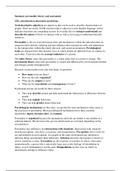Summary
Samenvatting Persoonlijkheidsleer en -Onderzoek Jaar 1.5 Psychologie
- Course
- Institution
- Book
Dit is een erg complete samenvatting voor het vak Persoonlijkheidsleer en -Onderzoek van het eerste jaar psychologie. De samenvatting is gebaseerd op het boek Personality Psychology van R. Larsen, D. Buss, A. Wismeijer en J. Song en informatie uit de hoorcolleges.
[Show more]




